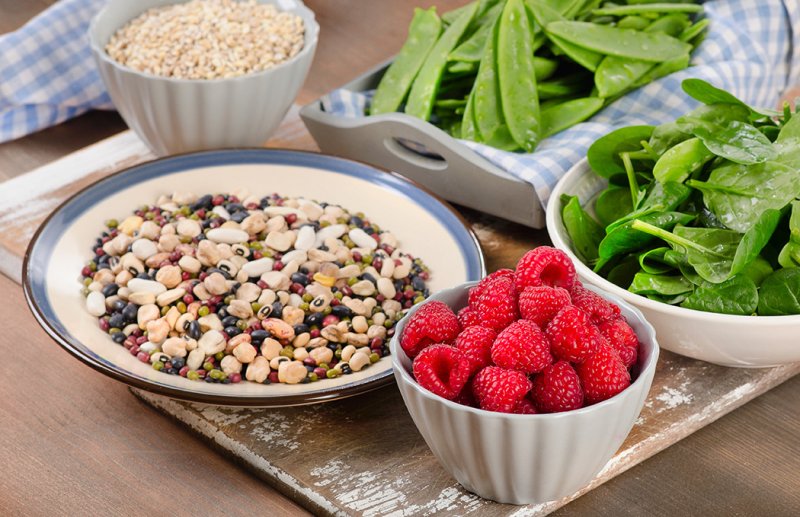
The pursuit of sustainable weight loss is a journey many embark on, often navigating a labyrinth of conflicting dietary advice. While calorie deficit, macronutrient balance, and regular exercise form the cornerstones of any effective weight management strategy, one crucial, yet often underestimated, component stands out: dietary fiber. Far from being merely a digestive aid, fiber is a potent ally in the quest for lasting weight loss, offering a multifaceted approach to satiety, metabolic health, and gut wellness.
Nutritionists universally laud fiber for its profound impact on the body, particularly when the goal is to shed excess weight and maintain a healthy physique. It’s not about quick fixes or restrictive diets; it’s about strategic food choices that nourish the body, promote fullness, and support optimal bodily functions. This article delves into the science behind fiber’s efficacy in weight loss and presents the top 10 fiber-packed foods that nutritionists consistently recommend for those seeking sustainable results.
The Science Behind Fiber and Sustainable Weight Loss
Dietary fiber, a type of carbohydrate that the body cannot digest, plays a pivotal role in weight management through several interconnected mechanisms:
Enhanced Satiety and Reduced Calorie Intake: Fiber, particularly soluble fiber, absorbs water and forms a gel-like substance in the digestive tract. This slows down gastric emptying, prolonging the feeling of fullness and reducing the likelihood of overeating. Insoluble fiber, on the other hand, adds bulk to stools, contributing to a sense of satiety by physically filling the stomach. By promoting sustained fullness, fiber naturally helps to reduce overall calorie consumption without feelings of deprivation.
Blood Sugar Regulation: Fiber helps to stabilize blood sugar levels by slowing the absorption of glucose into the bloodstream. This prevents rapid spikes and subsequent crashes in blood sugar, which often trigger cravings for sugary or high-fat foods. Stable blood sugar also reduces insulin resistance, a condition implicated in weight gain and difficulty losing weight.
Improved Gut Health and Microbiome Balance: A healthy gut microbiome is increasingly recognized as a key player in weight regulation. Fiber acts as a prebiotic, feeding beneficial gut bacteria. These bacteria ferment fiber into short-chain fatty acids (SCFAs) like butyrate, propionate, and acetate, which have been shown to influence satiety hormones, reduce inflammation, and improve metabolic health, all of which are conducive to weight loss.
Lower Caloric Density of Fiber-Rich Foods: Foods naturally rich in fiber are often less calorically dense than their refined counterparts. This means you can eat a larger volume of food for fewer calories, contributing to a feeling of satisfaction while adhering to a calorie-controlled diet.
Reduced Fat Absorption: Some types of soluble fiber can bind with dietary fats in the digestive tract, preventing their full absorption and leading to increased excretion. While not a primary mechanism, it contributes marginally to the overall fat loss equation.
Considering the recommended daily fiber intake for adults is typically 25 grams for women and 38 grams for men, incorporating fiber-rich foods strategically is paramount. Here are the top 10 foods nutritionists champion for lasting weight loss:
The Top 10 Fiber-Packed Foods Nutritionists Swear By
Lentils (and other Legumes):
- Fiber Content: Approximately 15 grams per cooked cup.
- Benefits: Lentils are nutritional powerhouses, packed with both soluble and insoluble fiber, plant-based protein, iron, and B vitamins. Their high fiber and protein content make them incredibly satiating, helping to stabilize blood sugar and prevent post-meal hunger.
- Weight Loss Mechanism: The combination of protein and slow-digesting complex carbohydrates (including fiber) in lentils provides sustained energy and fullness, reducing overall calorie intake.
- Incorporation: Add to soups, stews, salads, or use as a meat substitute in vegetarian dishes.
Raspberries (and other Berries):
- Fiber Content: Roughly 8 grams per cup.
- Benefits: These vibrant berries are not only delicious but also rich in fiber, vitamin C, and powerful antioxidants. They offer a natural sweetness without the blood sugar spike associated with refined sugars.
- Weight Loss Mechanism: The high fiber content aids digestion and promotes satiety, while the relatively low calorie count and natural sweetness make them an ideal healthy snack or dessert.
- Incorporation: Enjoy fresh, frozen in smoothies, atop yogurt, or mixed into oatmeal.
Avocado:
- Fiber Content: Around 10 grams per medium avocado.
- Benefits: Beyond its healthy monounsaturated fats, avocado is an excellent source of fiber, potassium, and vitamins K, C, B5, B6, and E.
- Weight Loss Mechanism: The unique combination of fiber and healthy fats contributes to profound satiety, reducing cravings and promoting a feeling of fullness for hours.
- Incorporation: Add to salads, sandwiches, smoothies, or enjoy mashed as guacamole or on whole-grain toast.
Chia Seeds:
- Fiber Content: Roughly 10 grams per 2 tablespoons.
- Benefits: These tiny seeds are fiber champions, predominantly soluble fiber, along with omega-3 fatty acids, protein, and various minerals (calcium, magnesium, phosphorus).
- Weight Loss Mechanism: When mixed with liquid, chia seeds swell significantly, forming a gel that slows digestion and creates a substantial feeling of fullness, helping to control appetite.
- Incorporation: Stir into yogurt, oatmeal, smoothies, or make a chia seed pudding.
Oats (Steel-cut or Rolled):
- Fiber Content: Approximately 4 grams per cooked half-cup.
- Benefits: Oats are renowned for their beta-glucan, a type of soluble fiber that is particularly beneficial for heart health and blood sugar control. They also provide essential minerals like manganese and phosphorus.
- Weight Loss Mechanism: The beta-glucan in oats forms a viscous gel that prolongs digestion, enhances satiety, and helps regulate blood sugar, preventing energy crashes and subsequent hunger pangs.
- Incorporation: Start your day with a bowl of oatmeal, use in homemade granola bars, or add to baking.
Broccoli (and other Cruciferous Vegetables):
- Fiber Content: About 2.4 grams per cup, cooked.
- Benefits: Broccoli is a nutrient-dense vegetable, offering fiber, vitamins C and K, folate, and potent anti-cancer compounds.
- Weight Loss Mechanism: Its high water and fiber content provide significant bulk with minimal calories, filling you up without contributing to caloric excess. The fiber also aids in healthy digestion.
- Incorporation: Steam, roast, stir-fry, or add to salads and pasta dishes.
Apples:
- Fiber Content: Roughly 4 grams per medium apple.
- Benefits: Apples are a classic healthy snack, rich in soluble fiber (pectin) and various antioxidants. They also contain a good amount of water.
- Weight Loss Mechanism: The combination of water and fiber, particularly pectin, contributes to satiety and helps regulate blood sugar, making apples an excellent choice to curb cravings between meals.
- Incorporation: Eat whole as a snack, slice into salads, or bake.
Sweet Potatoes:
- Fiber Content: Approximately 3.8 grams per medium potato, baked with skin.
- Benefits: These vibrant tubers are a fantastic source of complex carbohydrates, fiber, beta-carotene (Vitamin A), and vitamin C.
- Weight Loss Mechanism: The fiber in sweet potatoes, especially when consumed with the skin, slows down the release of glucose into the bloodstream, providing sustained energy and satiety, preventing energy dips that can lead to unhealthy snacking.
- Incorporation: Bake, roast, mash, or incorporate into stews as a healthier alternative to refined starches.
Artichokes:
- Fiber Content: Around 10 grams in one medium artichoke.
- Benefits: Often overlooked, artichokes are one of the most fiber-dense vegetables, also rich in antioxidants, folate, and vitamin K.
- Weight Loss Mechanism: Their exceptional fiber content promotes profound satiety and aids digestion, supporting a healthy gut microbiome, which is crucial for metabolic health and weight loss.
- Incorporation: Steam or roast whole, or add canned/frozen artichoke hearts to salads, pizzas, or pasta.
Quinoa:
- Fiber Content: Approximately 5 grams per cooked cup.
- Benefits: Quinoa is a complete protein, meaning it contains all nine essential amino acids, alongside being a good source of fiber, iron, magnesium, and manganese.
- Weight Loss Mechanism: The synergy of fiber and complete protein in quinoa makes it highly satiating and helps stabilize blood sugar, preventing overeating and supporting muscle preservation during weight loss.
- Incorporation: Use as a base for salads, a side dish, or as a substitute for rice in various recipes.
Incorporating Fiber Effectively and Safely
While the benefits of fiber are undeniable, it's crucial to increase fiber intake gradually. A sudden drastic increase can lead to digestive discomfort such as bloating, gas, and cramping. Start by adding one new high-fiber food per day or increasing your portion sizes slightly, then progressively build up.
Crucially, adequate hydration is non-negotiable when increasing fiber intake. Fiber absorbs water, and without sufficient fluid, it can lead to constipation rather than relief. Aim for at least 8-10 glasses of water daily.
Prioritizing whole, unprocessed foods over fiber supplements is always recommended. Whole foods offer a spectrum of nutrients and different types of fiber working synergistically, which supplements often lack.
Conclusion
Embracing a fiber-rich diet is a scientifically sound and sustainable strategy for achieving and maintaining a healthy weight. By promoting satiety, regulating blood sugar, fostering a healthy gut, and providing essential nutrients, the foods listed above offer a powerful toolkit for lasting weight loss. However, it's important to remember that fiber is one piece of a larger puzzle. Combining these fiber-packed foods with a balanced overall diet, regular physical activity, sufficient sleep, and stress management will provide the most comprehensive and effective path toward long-term health and weight management success. Consult with a registered dietitian or nutritionist to tailor these recommendations to your individual needs and health goals.







0 Comments
Post Comment
You will need to Login or Register to comment on this post!